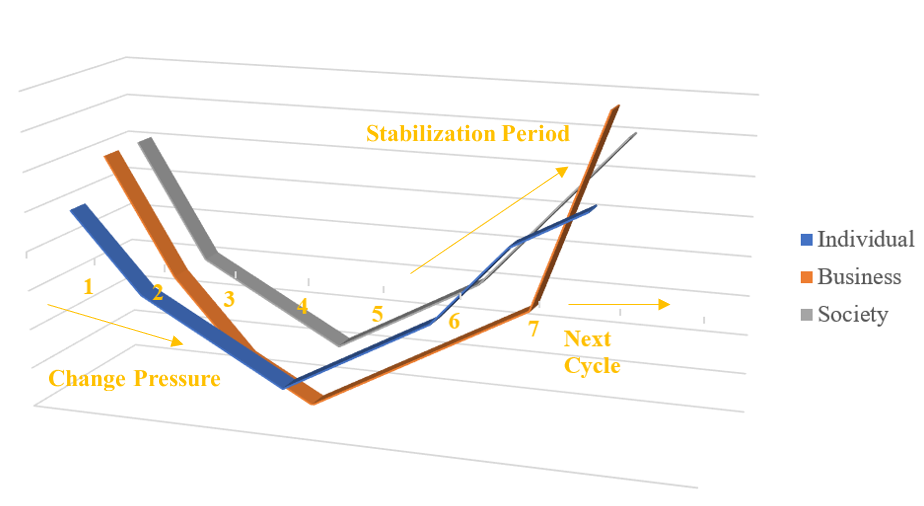Continuous Development
In recent years, the topic of change has gained significant traction in both academic and empirical fields. Rapid evolution in business and social environments compels companies, societies, and individuals to continuously adapt and innovate. This necessity for constant development has made change a recognized norm across all industries and markets, transforming continuous change management into a critical component of organizational ecosystems.
Leaders must recognize that change is an intrinsic characteristic of the nature. Continuous transformation is not a finite goal but an ongoing process that requires strategic planning and execution. Understanding the continuous development life-cycle is essential for achieving sustainable outcomes. Figure 1 illustrates the pivotal milestones within this cycle.
Figure 1: The Continuous Development Life-Cycle
Source: Adapted from Elisabeth Kübler-Ross Change Curve (Kübler-Ross and Kessler, 2005)
The continuous development cycle encompasses seven distinct phases:
1. Shock, the initial response to unexpected change, characterized by surprise and confusion.
2. Denial, a phase where individuals or organizations resist acknowledging the change, often attempting to maintain the status quo.
3. Frustration, recognition of the change begins, leading to feelings of frustration and resistance as the reality of the situation sets in.
4. Acceptance of Reality, acknowledgement and acceptance of the change, enabling the transition to proactive adaptation.
5. Testing, Exploration, and Learning, engaging in new behaviours and strategies to adapt to the change, fostering a culture of learning, experimentation and design thinking.
6. Integration, successful incorporation of new methods and practices into the organizational, social and individual routine.
7. Acknowledgement of Benefits and Celebration, recognizing and celebrating the successes and benefits achieved through the change process.
Each phase is interconnected and contributes uniquely to the overall success of change management. Leaders must evaluate the perceived benefits and drawbacks at each stage and adjust their strategies accordingly. By comprehensively understanding the continuous development life-cycle, leaders are equipped to address the uncertainties, ambiguities, and complexities inherent in transformation processes.
Further, exploring the dependencies between current and subsequent phases allows for the identification and resolution of potential issues. This approach ensures a deep understanding of the need for change, fosters active employee participation in transformation programs, and encourages openness to alternative solutions.
Furthermore, grasping the continuous development life-cycle enables leaders to:
· Engage all key stakeholders
· Facilitate inclusive participation and buy-in from all relevant parties
· Identify heuristics for better decision-making
· Develop practical rules of transformation projects that aid in effective decision-making under uncertainty
· Apply sound theories and robust procedures that help navigate the development cycles
· Shape long-term possibilities
· Envision and create sustainable future opportunities
Additionally, this understanding enhances the decision-making process by recognizing patterns, psychological factors, and the necessity for social technology. Continuous development is a rigorous endeavour that integrates both art and science. It demands a sophisticated approach that blends intuitive understanding with empirical evidence to navigate the complexities of organizational change successfully.
Importantly, by delving into the detailed phases and strategies of continuous development, leaders can cultivate a robust framework for guiding their organizations and society in large through continuous transformation, ensuring resilience and long-term success.
References
Kübler-Ross E., Kessler D. On Grief and Grieving: Finding the Meaning of Grief Through the Five Stages of Loss (Scribner, 2005)






